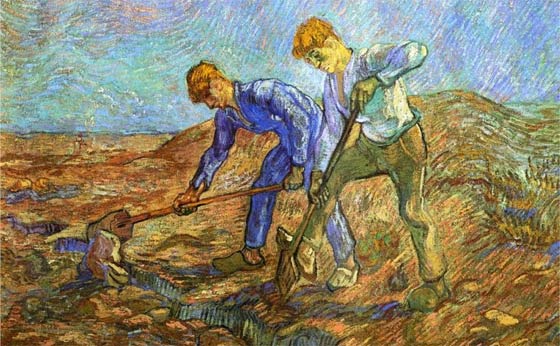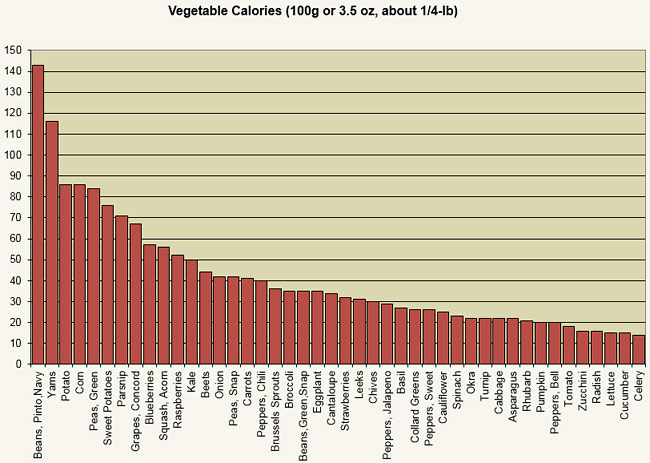While deciding which vegetables to grow in your ‘survival garden’, among the many things to consider might be the number of calories that you will get in return for the vegetables that you choose to grow.
In an environment in which you are doing your best to procure calories, this will be especially important as you seek to maximize your caloric return for your time and effort.
I have recently updated the following list of garden vegetables and their associated calories:
All quantities have been normalized to 100 grams (3.5 ounces or about 1/4-pound) so as to compare properly. That said, some of the foods are not typically consumed in these amounts – however the results will let you know where they list with regards to calories.
Nutrition is not accounted for in this list.
The food calorie data for each item was determined based on the common method of consuming the item (some are consumed raw whereas others are typically boiled, etc..).
Number Of Calories In Vegetables (CHART – GRAPH)
List Of Vegetables And Their Calories
Normalized to 100 grams (3.5 ounces, or about 1/4-pound)
Beans, Pinto, Navy (143 calories)
Yams (116 calories)
Potato (86 calories)
Corn (86 calories)
Peas, Green (84 calories)
Sweet Potato (76 calories)
Parsnip (71 calories)
Grapes, Concord (67 calories)
Blueberries (57 calories)
Squash, Acorn (56 calories)
Raspberries (52 calories)
Kale (50 calories)
Beets (44 calories)
Onion (42 calories)
Peas, Snap (42 calories)
Carrots (41 calories)
Peppers, Chili (40 calories)
Brussels Sprouts (36 calories)
Broccoli (35 calories)
Beans, Green, Snap (35 calories)
Eggplant (35 calories)
Cantaloupe (34 calories)
Strawberries (32 calories)
Leeks (31 calories)
Chives (30 calories)
Peppers, Jalapeno (29 calories)
Basil (27 calories)
Collard Greens (26 calories)
Peppers, Sweet (26 calories)
Cauliflower (25 calories)
Spinach (23 calories)
Okra (22 calories)
Turnip (22 calories)
Cabbage (22 calories)
Asparagus (22 calories)
Rhubarb (21 calories)
Pumpkin (20 calories)
Peppers, Bell (20 calories)
Tomato (18 calories)
Zucchini (16 calories)
Radish (16 calories)
Lettuce (15 calories)
Cucumber (15 calories)
Celery (14 calories)
Yams (116 calories)
Potato (86 calories)
Corn (86 calories)
Peas, Green (84 calories)
Sweet Potato (76 calories)
Parsnip (71 calories)
Grapes, Concord (67 calories)
Blueberries (57 calories)
Squash, Acorn (56 calories)
Raspberries (52 calories)
Kale (50 calories)
Beets (44 calories)
Onion (42 calories)
Peas, Snap (42 calories)
Carrots (41 calories)
Peppers, Chili (40 calories)
Brussels Sprouts (36 calories)
Broccoli (35 calories)
Beans, Green, Snap (35 calories)
Eggplant (35 calories)
Cantaloupe (34 calories)
Strawberries (32 calories)
Leeks (31 calories)
Chives (30 calories)
Peppers, Jalapeno (29 calories)
Basil (27 calories)
Collard Greens (26 calories)
Peppers, Sweet (26 calories)
Cauliflower (25 calories)
Spinach (23 calories)
Okra (22 calories)
Turnip (22 calories)
Cabbage (22 calories)
Asparagus (22 calories)
Rhubarb (21 calories)
Pumpkin (20 calories)
Peppers, Bell (20 calories)
Tomato (18 calories)
Zucchini (16 calories)
Radish (16 calories)
Lettuce (15 calories)
Cucumber (15 calories)
Celery (14 calories)
As most of you know, in general vegetables are not very calorie dense (with some exceptions – potatoes, etc..) and this is why many weight loss programs will emphasize eating more vegetables in your diet (which also benefits in additional ways – fiber, nutrition). However when considering a ‘survival garden’, suddenly we are concerned about calories in another way – to maximize the garden’s output based on not only diversification of nutrition, one’s grow zone limitations, and the things that you ‘like’, but it will become important to consider calories (as in ‘survival’ mode). If one were to eat vegetables alone, it would take lots to consume approximately 2000 calories per day (or more if you’re working hard)!
Based on your own grow zone, you might not be able to grow all of these foods. For example I live in a northern climate and there are several items that will not be successful up here.
Here’s an article that I wrote awhile ago with references to an excellent grow zone map utility.
Frost Hardiness Planting Zones, And Your Growing Season
Frost Hardiness Planting Zones, And Your Growing Season


No comments:
Post a Comment
Note: Only a member of this blog may post a comment.